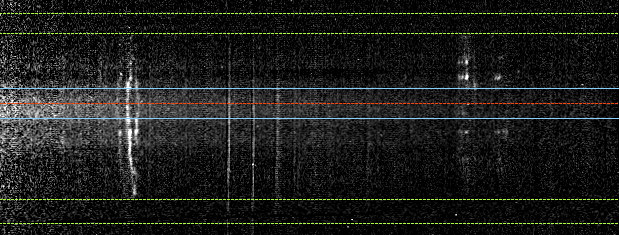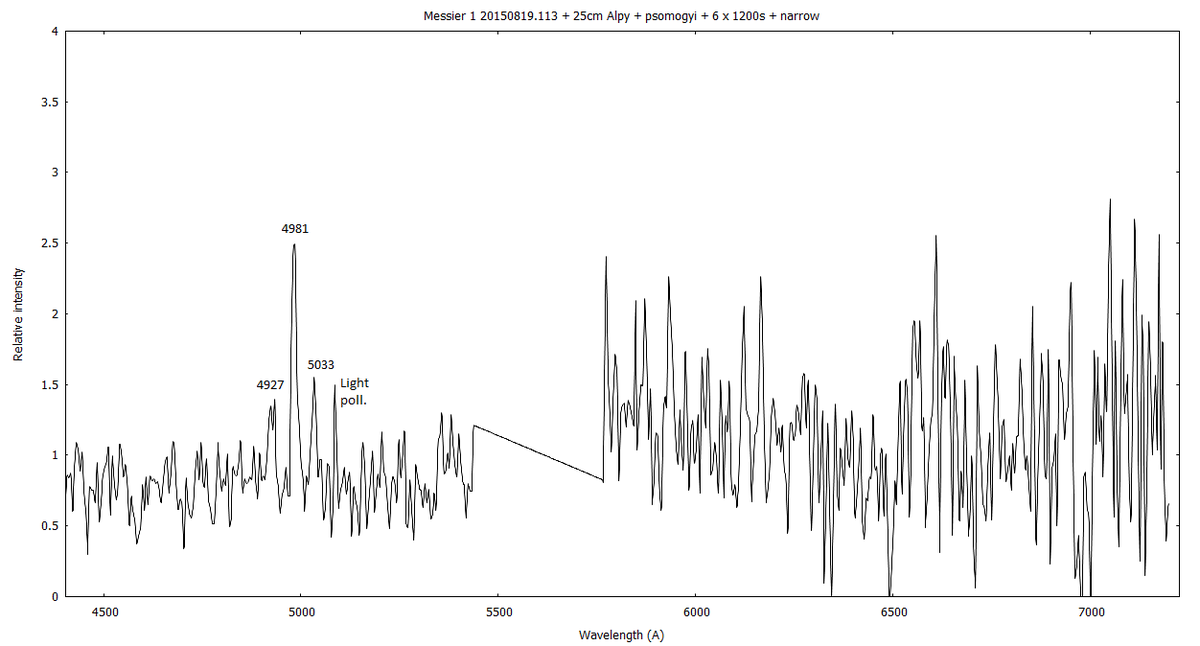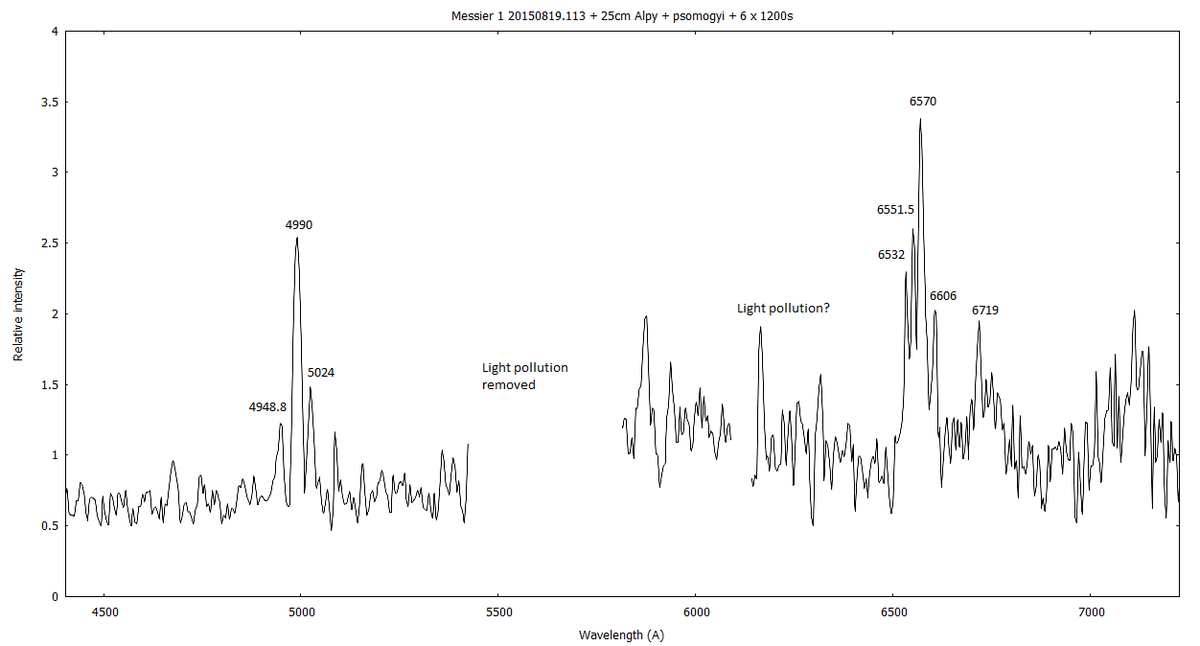Page 1 of 1
Messier 1
Posted: Sun Aug 16, 2015 1:53 pm
by Peter Somogyi
Last year I was taking a deepsky object chosing Messier 1 for an experiment, but got the knowledge for processing only much later.
Now I got the time to process it and measure the speed of gas.
To max it out, I've applied this narrow region:

- Binning for narrow use
- m1_bin_narrow.png (157.43 KiB) Viewed 6238 times
The result spectrum:

- Narrow reduced spectrum
I have the wide binned version too including H-alpha which is away a bit, but for now the measurement is the only important.
So what I've measured: 5033A - 4981A = 52A (as a verification: 5007A is just in the middle!)
That means (52A/5007A) * 300000 km/sec= 3115 km/sec for me.
I did find this link doing similar:
http://www.astrosurf.com/buil/us/mission2/mission2.htm
But result is different (unclear to me how the 14A was measured and how the 2400 km/sec came out).
Maybe I've taken it at a different position. I don't think my calibration was bad, processing Iot Tau as a ref.star showing good wavelenghts. Or was there some change since 2002 ?
BTW the wide binned spectrum looks this:

- Full width spectrum
Light pollution is very much there, at this wide background couldn't properly remove.
All processed by ISIS software (+ win7 paint and gnuplot).
Cheers,
Peter
Re: Messier 1
Posted: Sun Aug 16, 2015 2:18 pm
by Peter Somogyi
+ info left:
acquisition camera: Orion G3, 1x1 bin, +5 C
25cm/1000 Newton (f/4)
Slit has cut through just the middle of M1, I can put it out if really interesting (few secs, almost no signal).
Re: Messier 1
Posted: Sun Aug 16, 2015 4:19 pm
by Robin Leadbeater
Hello Peter,
I think there is a typo in the Pic du Midi measurement. (2400 km/s =~ 41A at 5007A not 14A) This would agree better with the image of the spectrum there. This is the difference in RV between the front and the back of the expanding shell. (We see both because the nebula is transparent, note how the two parts of the split lines converge at the "poles" of the nebula)
I do not know why your figure is higher though. Perhaps your measurement was more centred and the pic du midi measurement was offset so did not see the maximum expansion velocity or maybe it was taken at a different angle and the expansion velocity is not radially symmetric ? (The Crab Nebula does not look very spherical!)
Cheers
Robin
Re: Messier 1
Posted: Sun Aug 16, 2015 4:41 pm
by Robin Leadbeater
The line at 4981 could also be a blend of the redshifted 4959A and the blue shifted 5007A [OIII] lines. An alternative measurement could be made from the blue shifted 4959 line to the redshifted 5007 line, minus the difference in rest wavelength between the two lines This would work out for your spectrum as (5033-4927) -(5007-4959) = 58A. This is an even larger difference though

Robin
Re: Messier 1
Posted: Sun Aug 16, 2015 6:01 pm
by Peter Somogyi
Hello Robin,
I see it now, possibly doing it at shorter focal length gave the chance to catch higher RVs (wider region at the center).
It should be publicly available somewhere, as the maximum value should be relevant in the distance calculus, I would assume.
I wonder if this speed can change, or can we assume constant.
My material is so noisy and polluted to tell how the 4959-red and 5007-blue blend together, I am surprised how the Pic du Midi spectrum was made in 2002 at that high quality, I thought the f-ratio matters not the mirror size.
But you're right, using the 4927A (=redshifted 4959A) and 5033A (=blueshifted 5007A) can give a more accurate result, as the middle line is really blended. I was not aware of this trick

So the 58A is giving 3491 km/sec then (using the half wavelength between 5007, 4959 as a base).
Cheers,
Peter
Re: Messier 1
Posted: Mon Aug 17, 2015 1:08 pm
by Robin Leadbeater
I had a quick looked in Wikipedia (Perhaps not the most reliable of sources

) which quotes a figure of 1500 km/s expansion rate for the Crab nebula compared with your 3500/2 = 1750km/s so reasonably close. The reference given in wikipedia (using radio measurements) is
http://adsabs.harvard.edu/abs/1991ApJ...373L..59B
Cheers
Robin
Re: Messier 1
Posted: Mon Aug 17, 2015 9:15 pm
by Peter Somogyi
Although I couldn't find any recent material, that document looks to be rather old.
It mentions some "relativistic bubble" and "post-SN acceleration", maybe there is something to do with.
But I need more time to digest.
Meanwhile looking into Richard Walker's spectroscopic atlas, 41A and 31A was mentioned.
Maybe I should schedule another try, at a higher res.
Slit position:

- m1.png (853.92 KiB) Viewed 6151 times
(no coma corrector, lodestar X2, f/4)
I think I had saved it while already guiding (just for safety), exposure was less than 1 sec.
Cheers,
Peter